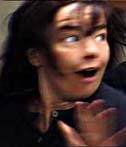
Movie Guru Rating:

Comment
on this review
| |

Dancer in the Dark pits its heroine against its director
by Jesse Fox Mayshark
Dancer in the Dark is an imaginative, original, and sometimes dazzling film, and I didn't believe a single second of it.
It's a musical, or a movie about musicals, or a movie about being a movie about musicals, or some combination of all of those. If that sounds too conceptual, post-mod, or arty for you, don't worry. Once you boil off all the movie's pretenses, you're left with nothing but suds. At heart, the film is pure soap opera. That it could have been more is a testament to the talents of its remarkable leading lady; that it settles for less is a sign of the uncertainties of its creator.
It's the latest bit of mischief from Danish director Lars von Trier, who made Zentropa and Breaking the Waves and also founded the idiosyncratic Dogme 95 movement. He and a handful of peers swore to a set of filmmaking rules that eschewed artificial light, overdubbing, and various Hollywood narrative conceits in favor of "realistic" acting and hand-held camerawork. But as with everything von Trier does, it was hard to know how seriously to take Dogme, and Dancer in the Dark suggests that he's not sure either.
It's a histrionic melodrama about a Czech immigrant, Selma (played by eccentric Icelandic pop singer Björk), a single mother raising a son somewhere in the Pacific Northwest. She works on an assembly line making steel sink basins and lives in a trailer owned by local police officer Bill (David Morse) and his wife Linda (Cara Seymour). She also loves musicals and is rehearsing to star in a community production of The Sound of Music.
Selma's secret, which she keeps even from her one close friend Kathy (a demure Catherine Deneuve, if you can imagine such a thing), is that she's going blind. Moreover, her 12-year-old son Gene has the same congenital condition, although he doesn't know it. Selma has brought him to the U.S. for an operation that could save his sight, but doctors say he can't have the surgery until he's 13. Selma's saving up money to pay for the procedure. Meanwhile, the apparently good-hearted Bill has a secret of his own, one that makes Selma's hidden savings look awfully tempting.
And then...well, what do you think happens? In a nutshell, things go from bad to worse, in plot twists that require increasingly unlikely behavior from the story's characters. But this is a musical, remember? As Selma's life becomes bleaker and bleaker, she turns more and more inside herself with song-and-dance fantasies that von Trier presents in luminescent video sequences (in bright contrast to the rest of the movie's grainy film stock). These scenes are the heart of Dancer in the Dark, both because of von Trier and Björk's obvious delight in them and because they are liberated from the labored contrivances of the film's "real life" world. Björk, who wrote and sang the songs herself, was a perfect choice for the project. Her music, which draws on everything from big-band swing to moody jazz to industrial techno, has always had theatrical flair. Here, she uses environmental noise from Selma's daily life (machines and trains and marching feet) as a jumping-off point for her woozy, joyous bursts of noise and color. Her voice, with its whispers and cracks and squeals, is an ideal vehicle for Selma's delusional escapes.
The film's themes—the clash between inner fantasies and outer realities, the way movies shape our dreams, the futility of seeking transcendence outside yourself—are neither original nor particularly well articulated. Compared to Woody Allen's The Purple Rose of Cairo, for example, or the film and TV versions of Pennies From Heaven, Dancer in the Dark seems heavy-handed and clumsy. Von Trier has always been in danger of being too clever by half, and this time it trips him up. You can tell from the exuberance of his musical numbers that part of him is drawn to Selma's guileless determination. But the cynic in him can't resist dashing her repeatedly into the rocks.
Fortunately, his neophyte star has no such divided loyalties. Björk, who won best actress honors at Cannes, gives Selma's naiveté a ferocity that saves her from turning into a simpleton. When she springs into her first big dance routine, it doesn't seem out of character because we have already seen glimpses of Selma's boisterous inner life. The rest of the cast is more experienced, but none of them matches Björk's full-on embrace of von Trier's improbable world. (Ironically, the director and star reportedly clashed constantly on the set, with Björk at one point storming off for several days.)
Unfortunately, the thickly plotted movie bogs down its heroine. Von Trier himself seems unclear where he's headed until, in the final scene, he makes an unorchestrated and breath-taking bid for redemption. If it had been better supported and more deeply felt, it could have ended the movie on a note of something like true grace. Instead, it seems like the conclusion to a different and better film than this one.
Dancer in the Dark affirms what von Trier's other projects (including the madly inventive Danish TV series The Kingdom) have already attested: he's a talented, playful, and sometimes visionary iconoclast. He's also a pretentious smarty-pants, and his substitution of one set of constraints for another (Dogme rather than Hollywood) is as irritating as it is admirable. You could almost read Dancer as an argument with himself—the musical sequences violate most of the Dogme dogma, while the narrative mostly conforms to it. I hope von Trier notices which parts actually feel most alive. As his collaborator Björk already knows, art doesn't have to follow any rules.

October 12, 2000 * Vol. 10, No. 41
© 2000 Metro Pulse
|